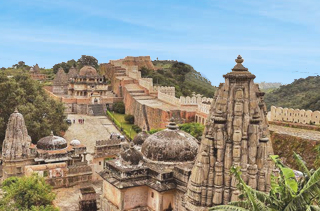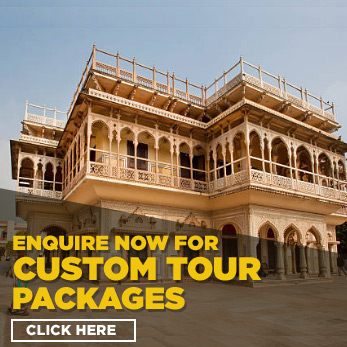Jaipur (also known as the Pink City), is the capital of Rajasthan in India.
Jaipur is the largest city in Rajasthan and was built in the eighteenth century by Sawai Jai Singh as India's first planned city. Jaipur is a major tourist attraction amongst Indian as well as international travellers. It belongs to the tourist Golden Triangle of Delhi, Jaipur and Agra. It hosts several attractions like the City Palace, Govind Dev ji Temple, Vidhan Sabha, Birla Temple, several massive Rajput forts and so on. It also serves as a stepping stone for travelers heading to the desert cities of Jodhpur and Jaisalmer.
Now Jaipur is growing fast and various development projects are being undertaken by the government and private enterprises. The town planning and infrastructure development in Jaipur is quite above the mark relative to many other Indian cities.
Jaipur is often called the Pink City in reference to its distinctly colored buildings, which were originally painted this color to imitate the red sandstone architecture of Maugham cities. The present earthy red color originates from repainting of the buildings undertaken for a visit by the Prince of Wales in 1876.
Tourist Places to visit In Jaipur
Amber Fort
One of the top tourist attractions of Jaipur, the huge Amer Palace Fort sits atop a small hill, and is located at a distance about 11 km from the main city. The magnificent Amer Fort is an extensive palace complex that has been built with pale yellow and pink sandstone, and with white marble. The fort is divided into four main sections that are graced with their own courtyards.
As you arrive at the Amer Fort, you will enter through the Suraj Pole unless you arrive by car, then you enter via the Chand Pol. Both these gates open into the Jaleb Chowk, which is the main courtyard, where in earlier times, returning armies used to display their plunder to the people. The fort has a number of sections, including the King’s quarters, the zenana (where the women lived), gardens, temples, etc.
There are a lot of attractions for one to see at the Amer Fort, including the diwan-e-aam, such mandir, and the Sheesh Mahal. Amer Fort is also home to some underground tunnels that connect Amer to Jaigarh Fort. A part of these tunnels has been restored, and is now open to public as well. Encompassing all this, the Amer Fort is a perfect example of Rajasthani architecture which is a must-visit.
The essence of Amer Fort is encapsulated by the beautiful light and sound show within the fort, where visitors get to see an astounding spectacle about the history of the fort.
City Palace
Located deep within the walled city, the City Palace Complex was conceived and built by Maharaja Sawai Jai Singh II, the founder of Jaipur. A beautiful fusion of Mughal and Rajput architecture, the palace is still home to the last ruling royal family which lives in a private section of the palace. Maharaja Sawai Jai Singh II is credited with building most of the structures, but it was expanded upon by later rulers as well. The City Palace Complex includes the Mubarak Mahal (the palace of reception) and the Maharani’s Palace (the palace of the queen). Mubarak Mahal now houses the Maharaja Sawai Man Singh II Museum and displays a vast and unique collection of royal costumes, delicate Pashmina (Kashmiri) shawls, Benaras silk saris, and other dresses with Sanganeri prints and folk embroidery. The clothes of Maharaja Sawai Madho Singh I are also on display. The Maharani's Palace, surprisingly, has an interesting display of very well-preserved Rajput weaponry, some dating back to the 15th century. Other than the arms, the palace is adorned with beautiful paintings on the ceiling that are well-maintained.
Jantar Mantar
Jantar Mantar is one of the oldest astronomical observatories featuring the world’s largest stone sundial, located in the heart of Jaipur. It is no longer a working science center but is maintained as a monument, and education activity sessions, guided tours and music and light shows, are organized here. Jantar Mantar in Jaipur is one of the largest observatories in the world, comprising of remarkable stone assemblies that help to interpret the position of celestial bodies and calculate local time. Enumerated as a World Heritage Site by UNESCO, Jantar Mantar attracts tourists, historians, astronomers, architects, mathematicians, and geographers. The collection of nineteen astronomical instruments in Jantar Mantar allows the observation of astronomical positions with the naked eye. The monument is an exemplification of architectural innovations that was built on ideas from different religious and social beliefs in 18th-century India.
Hawa Mahal
The Hawa Mahal in Jaipur is considered as one of the most iconic attractions of the city. The five-storey building looks like a honeycomb of a beehive and it is always windy inside, owing to the numerous windows and jharokhas. This amazing ventilation that the palace enjoys is the reason why it was named as the Hawa Mahal, which literally translates into the "Palace of the Winds".
Albert Hall Museum (Central Museum)
The building gets its name from The Victoria and Albert Museum in London, the inspiration for its design. The exquisitely built Albert Hall is housed in the centre of Ram Niwas Garden. Sir Swinton Jacob (who is also the mastermind behind many other palaces in Rajasthan) conceptualised and designed it using styles from the Indo-Sarcenic architecture and the Prince of Wales laid the foundation stone of the building in 1876. The museum displays a wide range of metal objects, wood crafts, carpets, stone and metal sculptures, arms and weapons, natural stones and ivory goods. It also houses a large collection of miniatures from Bundi, Kota, Kishangarh, Udaipur and Jaipur schools of art.
Jal Mahal
The Jal Mahal literally means the “Water Palace”, but when it was built, Maharaja Madho Singh I did not intend to use it as a palace. Instead, it was supposed to be a hunting lodge for the king and his entourage during their duck hunting trips. The palace stands in the middle of the Man Sagar Lake in Jaipur city, and is a famous spot till date for sightseeing. The Jal Mahal is designed in a classic Rajput manner, with pink sandstone in a symmetrical style.
While a lot of people come to see the Jal Mahal from the banks of the Man Sagar Lake, not many are aware of the technology and innovative design that has gone into building this ancient palace. On the surface, the palace appears to have one floor, but actually, there are four more submerged levels to the palace as its stone walls hold back millions of litres of water, and the specially designed lime mortar prevents water seepage into the palace, something which it has been doing for more than 250 years.
For now, the palace is not open to a majority of the public, so tourists flock to the banks of the lake to gaze at this magnificent structure. In the evenings, the banks are full of street food vendors as well, and the place gets pretty crowded as people visit what is possibly the most serene spot in the hustle and bustle of the city. The light colour of the sandstone walls creates a sharp contrast with the deep blue of the lake, and one can also see some green foliage sprouting from the inner courtyards of the palace, making it one of the most photographed spots in Jaipur.
The main purpose behind the construction of this palace was to allow the ladies of the royal family and the court to observe the busy streets of the Johari Bazaar from the many jharokhas of the palace, without being seen themselves. The Hawa Mahal is a five-storey building, and it is the tallest building in the world that has been built without a foundation. It has a curved architecture that leans at an 87 degree angle, and a pyramidal shape which has helped it stay erect for centuries.
The Hawa Mahal is dedicated to Lord Krishna. It is said that the shape of the building resembles the crown of Krishna. More than a palace, the Hawa Mahal is also a cultural and architectural marvel that reflects a truly harmonious amalgamation of the Hindu Rajput and Islamic Mughal architectural styles. The Rajput style can be seen in the domes canopies and the fluted pillars, while the stone inlay filigree work and the arches are perfect depictions of the Mughal style of architecture.
Birla Temple
The Lakshmi-Narayan Temple, or the Birla Temple, as it is more popularly known as, is located at the base of Moti Dungari. Built on an elevated platform, this comparatively modern temple is built entirely of white marble and dominates the skyline of south Jaipur. The temple was commissioned and built by renowned Indian industrialists, the Birlas, in 1988. The temple is dedicated to Lord Vishnu, also called Narayan, and his companion, Lakshmi, the Goddess of wealth and good fortune. The temple is a work of art and has a marvellous display of exquisite carvings and sculptures covering many mythological themes. The eye is drawn to the images of Laxmi and Narayan, carved as they are, from one piece of marble. The top of the temple has three domes, each representing the three religions followed in India. This is designed to pay homage to secular India. The temple looks spectacular at night when it is lit up. Other than the main temple, the complex has a museum that exhibits the earlier belongings of the Birla family.
Jaigarh Fort
About 15 kilometres from Jaipur, Jaigarh Fort was built by Sawai Jai Singh II sometime in the early 18th century amidst the arid, rocky and thorn-scrub covered hills. Despite its ancient construction, it still retains most of its imposing citadel appearance. Visitors can see the world’s largest cannon – Jaiban, at the fort.
Nahargarh Fort
Nahargarh Fort sits proudly on a ridge of the Aravalli Hills, creating an impressive northern backdrop to the city of Jaipur. It was constructed during the reign of Jai Singh in 1734, and was later expanded in 1868. Nahargarh, which means abode of tigers, was a formidable barrier, defending Jaipur against attacking enemies. Within its walls, the fort houses Madhavendra Bhawan, the summer destination for the members of the royal family. Built by Sawai Madho Singh, the palace has 12 matching boudoirs for the queens, at the head of which is a suite for the king. They are all connected by corridors decorated with delicate murals. Even today the palace is a favoured spot for local picnickers. The fort looks brilliant when floodlit at night. Overlooking the city, it presents a glittering view of the city lights.
Govind Devji Temple
The Krishna temple is a rare spire-less temple and houses the idol of Govind Devji that Sawai Jai Singh brought from Vrindavan. The deity, worshipped by the erstwhile royal family, is also revered by the the locals in the area.
Galtaji Temple (Monkey Temple)
Galtaji is an ancient pilgrimage centre in Jaipur. Set amidst low hills and packed with locals and tourists alike, the attractive spot has temples, pavilions and holy kunds (natural springs and water tanks). Visitors to Galtaji will come across the complex of Ramgopalji temple, locally called the Monkey temple (Galwar Bagh). It gets this moniker because of a large group of resident monkeys. The green landscape and chattering monkeys add to the delight of the area. On top of the hill is a small temple dedicated to the sun god, called the Surya Mandir. Constructed by Diwan Kriparam, the temple can be seen from anywhere in the city.
Other Attractions and Places to Visit in Jaipur
- Jaipur Wax Museum, Nahargarh Fort
- Sheesh Mahal, Nahargarh Fort
- Raj Mandir Cinema
- Rajasthan Assembly Building
- Royal Gaitor
- Central Park
- Jawahar Circle
- Ram Niwas Garden
- Sisodia Rani Garden and Palace
- Kanak Vrindavan
- Moti Dungri Fort
How To Reach Jaipur
By Air: The Jaipur International Airport is called Sanganer Airport. There are domestic flight connections to and from Delhi, Kolkata, Mumbai, Ahmedabad, Jodhpur, Udaipur and several other places. There are also international flights from Jaipur to Dubai, Muscat, Singapore & Bangkok as well.
By Road: A convenient way to travel to Jaipur is by road. Regular service of AC and Deluxe buses is available from all major cities in Rajasthan.
By Train: Jaipur is connected via rail from all major cities including Delhi, Agra, Mumbai, Chennai, Kolkata, Bikaner, Jodhpur, Udaipur, Ahmedabad, Bangalore, etc.
Jaipur Images
Tours Starting from Jaipur

This 10 Nights / 11 days tour package brings the ethnic blending of Marwar and Mewar region of Rajasthan.
- 5N-6D Golden Triangle Tour Package
- Golden Triangle Tour with Bharatpur
- Golden Triangle Tour with Golden Temple
- Golden Triangle Tour with Jaisalmer
- Golden Triangle Tour with Jodhpur
- Golden Triangle Tour with Jodhpur and Jaisalmer
- Golden Triangle Tour with Mandawa
- Golden Triangle Tour with Neemrana
- Golden Triangle Tour with Nimaj and Udaipur
- Golden Triangle Tour with Pushkar
- Golden Triangle Tour with Ranthambore
- Golden Triangle Tour with Royal Rajasthan
- Golden Triangle Tour with Udaipur
- Golden Triangle Tour with Varanasi





